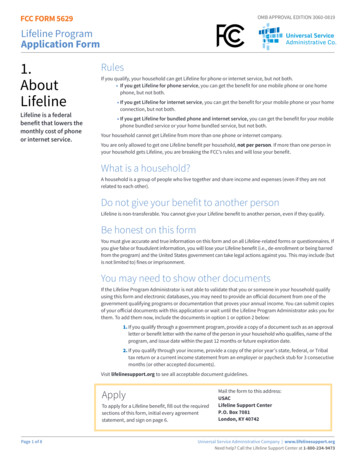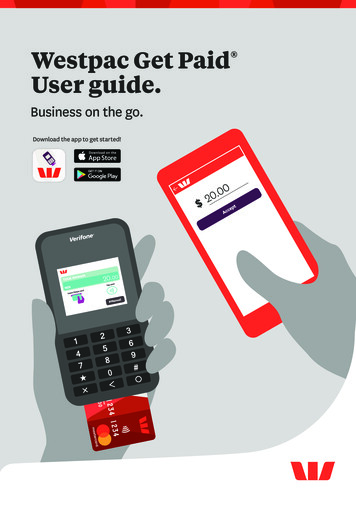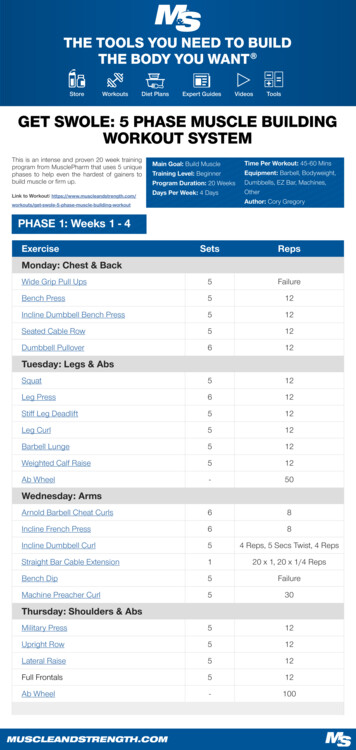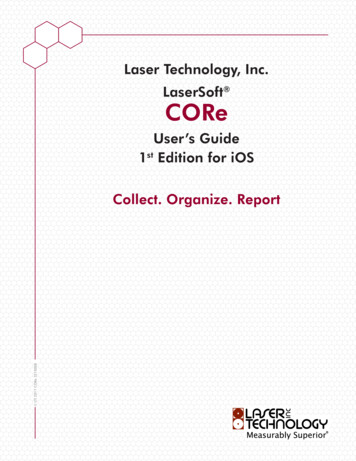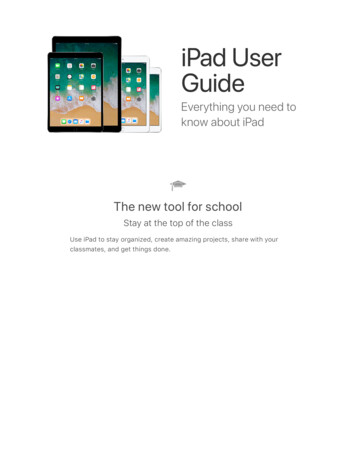
Transcription
How to get there? A critical assessment of accessibility objectives andindicators in metropolitan transportation plansABSTRACTAccessibility, the ease of reaching destinations, is increasingly seen as a complimentary and insome cases alternative to the mobility oriented planning paradigm, as it allows capturing thecomplex interactions between land use and transportation systems while providing a socialperspective on transportation planning. However, although accessibility has been extensivelyresearched in the last decades, it is still largely marginalized in transportation planning practice.Accordingly, the aim of this study is to critically assess how accessibility is incorporated intometropolitan transportation plans and translated into performance indicators around the world, toultimately derive policy recommendations. This research assesses 32 recent metropolitan transportplans from North America, Europe, Australia and Asia with respect to their goals, objectives andperformance indicators. The results suggest that there is a trend toward a greater integration ofaccessibility objectives in transport plans, yet few plans have accessibility-based indicators thatcan guide their decision-making processes. Our findings show that in order to foster accessibilitybased approaches to transportation planning, plans need to have clearly defined accessibility goalswith a distinction between accessibility and mobility. Furthermore, multi-criteria analysisapproaches including accessibility indicators need to guide the decision-making process. Thisstudy contributes to a greater understanding of the challenges and successes associated withimplementing accessibility in transport planning.Key words: Access to destinations; Performance indicators; Sustainable transportation; ParadigmshiftFOR CITATION PLEASE USE: Boisjoly, G., & El-Geneidy A. (2017). How to get there? A criticalassessment of accessibility objectives and indicators in metropolitan transportation plans. TransportPolicy, 55, 38-50.1
INTRODUCTIONAccessibility is increasingly seen as an alternative to mobility oriented planning paradigm (Geurs,Krizek, & Reggiani, 2012), as it allows capturing the complex interactions between land use andtransportation systems (Hansen, 1959) and provides a social perspective on transportation planning(Banister, 2008; Lucas, 2012). While mobility merely reflects the ease of moving, accessibilityaddresses the ease of reaching desired destinations, which is in fact the reason why peopleundertake trips (Preston & Rajé, 2007). Accessibility is one of the most comprehensive measuresto assess the complex performance of land use and transportation systems in a region. As it hasbeen well documented in the literature, accessibility can help in reducing car use, increasing socialequity, and support economic development. Accordingly, transportation planning is increasinglyframed in terms of access to opportunities (Geurs et al., 2012; Handy, 2008; Lucas, 2012;Manaugh, Badami, & El-Geneidy, 2015; Preston & Rajé, 2007). Nevertheless, the concept ofmobility is still prioritized over accessibility in practice (Halden, 2011; Levinson, 2005; Proffitt,Bartholomew, Ewing, & Miller, 2015).The aim of this paper is to critically assess how accessibility is incorporated into metropolitantransportation plans and translated into performance indicators around the world. This analysisseeks to identify best practices and provide guidelines on how to effectively use accessibility inplanning. In order to do so, a qualitative content analysis of 32 recent plans from metropolitanareas in North America, Europe, Australia and Asia is conducted. The analysis focuses on thevision, goals, objectives and performance indicators stated in the plans. The general trends as wellas the best practices are highlighted in this study. This study contributes to a greater understandingof practical challenges and successes associated with accessibility planning. This research is ofrelevance to decision-makers and transportation planners wishing to better integrate accessibilityin their plans and practice. It also provides researchers with a greater understanding of the currentplanning practices, and potentially contribute to bridging the gap between ongoing research andplanning practice.LITERATURE REVIEWWhat is Accessibility?In simple words, accessibility can be understood as the ease of reaching services and activities(Litman, 2013). For the purpose of this study, we focus on geographical accessibility, that is the2
ease of reaching destinations (Preston & Rajé, 2007). Following this definition, accessibility islargely contingent on the spatial distribution of destinations, the land use component, and theability to move from one place to another, the transport component (Geurs & van Wee, 2004). Theland use component is related to the spatial distribution of opportunities. Urban opportunities caninclude, but are not limited to, jobs, health services and retail stores. The transport componentrefers to the transport infrastructure specific to each mode. In addition to transport and land use,there are temporal and individual components to accessibility (Geurs & van Wee, 2004). Theavailability of opportunities for example (opening hours of shops and services, job starting time)represents temporal elements, whereas personal characteristics such as income and car ownershipreflect the individual component.Given the multiple components of accessibility, accessibility can be measured in differentways (Geurs & van Wee, 2004; Handy & Niemeier, 1997; Paez, Scott, & Morency, 2012). Firstly,accessibility can be measured at the individual level (person-based), or at the location level (placebased) (Miller, 2005). Whereas person-based metrics focus on the individual component, placebased metrics mainly account for the land use and transport components. The individualcomponent is sometimes included in location-based studies by stratifying population by age groupor socio-economic characteristics, and by segmenting destinations (by job types for example) (Fan,Guthrie, & Levinson, 2012; Alexandre Legrain, Buliung, & El-Geneidy, 2015; A. Legrain,Buliung, & El-Geneidy, 2016; Paez, Mercado, Farber, Morency, & Roorda, 2010). Location-basedaccessibility is most commonly used by policy-makers as it provides a comprehensive measure ofthe land use and transport system at the regional level (Dodson, Gleeson, Evans, & Sipe, 2007).Location-based metrics typically accounts for the number of opportunities that can be reachedfrom a specific location, based on the travel costs to destinations using a specific mode (Handy &Niemeier, 1997).Travel costs are generally measured based on travel time or distance (Geurs & van Wee,2004; Handy, 1994; Hansen, 1959; A. Owen & Levinson, 2014; Vickerman, 1974). Two locationbased measures are commonly used in accessibility research. The first one is the gravity-basedmeasure which discounts all opportunities based on their travel costs. The second one is thecumulative-opportunity measure, which only counts the opportunities that are within a specifictravel costs threshold. Gravity-based measures better reflect travel behavior as it accounts for thetravelers’ perceptions of time (Ben-Akiva & Lerman, 1979). This measure is, however, more3
complex to generate, as a distance-decay function must be calculated, and more difficult tointerpret and communicate, as it is not directly expressed in terms of the number of opportunities(Geurs & van Wee, 2004; A. Owen & Levinson, 2014). On the other hand, cumulative-opportunitymeasures are easy to generate and interpret. Furthermore, these measures are highly correlatedwith gravity-based measures (El-Geneidy & Levinson, 2006), and hence represent an adequatemeasure of regional accessibility (Boisjoly & El-Geneidy, 2016).From Mobility to AccessibilityTransportation planning has emerged as an isolated field that focused mainly on mobility, definedas the ease of moving. In this context, mobility indicators such as travel speed and travel timeswere put forward, with a focus on motorized transportation (Banister, 2008). Accessibility wasfirst introduced by Hansen in 1959 to capture the interaction between the land use and thetransportation networks. Following Hansen’s work, researchers started to emphasize the need toinclude accessibility as a performance indicator in land use and transportation plans as analternative approach to mobility-based transportation planning (Koenig, 1980; Morris, Dumble, &Wigan, 1979; Wachs & Kumagai, 1973). They argued that accessibility better reflected theeconomic and social benefits of the network, namely in terms of land values and quality of life(Koenig, 1980; Wachs & Kumagai, 1973). More recently, accessibility has been put forward as akey element of land use and transportation planning (Banister, 2008; Handy, 2002; Straatemeier,2008), namely with respect to social equity, economic development and environmental impacts(Handy, 2002; Lucas, 2012; Preston & Rajé, 2007). Whereas mobility-based approaches focus ontravel time minimization, planning for accessibility aims at providing all individuals with areasonable travel times to a variety of destinations (Banister, 2008). As a result, planning foraccessibility gives greater consideration to active and public transportation, and incorporate landuse policies that reduce distances between activities (Banister, 2008).Although accessibility has been a central theme of research in the last decades and hasrecently gained attention in the planning sector, transportation planning is still dominated by amobility-oriented paradigm. In a quantitative assessment of American transportation plans, Proffittet al. (2015) found that accessibility is increasingly incorporated in plans, especially in largermetropolitan areas, but is still marginally addressed compared to mobility. Furthermore, in thoseplans accessibility is often not clearly defined and thus often used as a buzzword. Similarly, in an4
assessment of four metropolitan plans in California, Handy (2005) found that plans weredeveloped around mobility. Nevertheless, the plans addressed some concerns with accessibility,although they were not defined as such. In the United Kingdom (UK) context, the concept ofaccessibility has been widely used, mainly due to the establishment of accessibility planningrequirements by the national government (Halden, 2011). However, given the broad and flexibleguidelines, accessibility is often “misused” and “abused in practice” (Halden, 2011). Furthermore,there is no consensus about which accessibility indicators and metrics should be used (Halden,2011). While a plethora of measures have been developed in academic settings, their practicalimplementation remains limited, which raises questions about their usability (Boisjoly & ElGeneidy, 2016; Curl, Nelson, & Anable, 2011; Geurs & van Wee, 2004). Overall, research hasshown that the paradigm shift from mobility to accessibility is far from complete. Accessibility isnot yet a mature concept in planning, and is accordingly not being used effectively.Given the increase interest in accessibility planning and the challenges related to itsimplementation, this study critically assesses transportation plans from metropolitan areas in NorthAmerica, Europe, Australia and Asia. This study expands upon existing research in the UnitedStates (US) and the UK to include a greater variety of planning contexts. Furthermore, no studyhas, to our knowledge, investigated a broad range of plans from a qualitative perspective to identifybest practices and successful implementations of accessibility indicators.RESEARCH FRAMEWORK AND METHODOLOGYThe ultimate goal of this study is to investigate which practices effectively incorporate accessibilityinto transportation planning. To achieve this research goal, this study explores the integration ofaccessibility into metropolitan transportation plans and seeks to answer the following researchquestions: To what extent and how is accessibility included in metropolitan transportation plansaround the world? To what extent are accessibility goals translated into performance indicators reflectingthe ease of reaching destinations? What are the best practices and how could accessibility objectives be better integrated inmetropolitan transportation plan?5
To address our research questions, we assessed long-range metropolitan transportation plans andrelated documents from 32 metropolitan areas around the world. We defined three inclusioncriteria for the metropolitan areas: population size, availability of documents and location. Firstly,we focused on metropolitan areas located in high-income countries, in order to get a relativelyhomogenous sample. Secondly, metropolitan areas with a population greater than 2.5 millioninhabitants were included. A lower population threshold (2 million) was selected for Europe, inorder to include a broader variety of metropolitan areas. Thirdly, the metropolitan area needed tohave a transportation plan available in English or French. In total, 18 metropolitan areas in theU.S. were selected, 3 in Canada, 8 in Europe, 2 in Australia, and one in Asia (Singapore). Therespective plans are presented in TABLE 1.Metropolitan transportation plans, which include goals, objectives, and indicators, havebeen selected to assess how accessibility is considered in urban transportation planning, as donein previous studies (Handy, 2005; Proffitt et al., 2015). Handy (2005) examined four metropolitantransportation plans to assess the use of mobility and accessibility in practice. Building on thisapproach, Proffitt et al. (2015) quantitatively assessed the use of accessibility in 42 metropolitanplans in the US. Manaugh et al. (2015) adopted a similar approach to examine how equityobjectives are included in transportation planning. Our study builds on these previous studies, andexpands the analysis conducted by Handy (2005) and Proffitt et al. (2015) by assessing a broadervariety of plans. Furthermore, a qualitative approach is taken to allow an in-depth understandingof the plans. Finally, metropolitan transportation plans were selected, rather than specific transitplans, in order to focus on authorities that typically deal with both land use and transportationstrategies, and to include all modes of transportation. Nevertheless, in most cases, metropolitantransportation plans incorporate the main elements of local transit plans, and set orientations forfuture transit development.For each metropolitan area, the most recent transportation plan was selected. Except forfour plans, all of them are from 2010 or later. Due to differences in political structures, there aresome discrepancies in the type of authority that developed the plan in each metropolitan area. Itwas typically a metropolitan planning organization, a City administration, or a transit agency.To answer our research questions, a structuring content analysis was conducted, with theaim of extracting the relevant material from the plans (Mayring, 2014). The analysis wasconducted in four phases. The first step consisted of skimming the planning document to identify6
the vision, goals, and objectives structuring the plan, if any. The second step was to carefullyexamine the performance indicators in each plan, with the purpose of extracting indicatorsreflecting accessibility or defined as such. A keyword in context analysis was then conducted,allowing to explore how the concept of accessibility was used (Hsieh & Shannon, 2005).Keywords such as access, accessibility, link, connection, reach, and “get to” were used. This stepwas conducted to find goals, objectives or indicators that might not have been collected in the firststep, and allowed to gain general understanding of the use of the concept of accessibility in theplan. Finally, a subset of plans was assessed more in details to evaluate accessibility analysis andaccessibility indicators. These plans were selected based on the previous steps, and the aim was tofind relevant and various examples of the use of accessibility indicators.The research method used in this study allows assessing the current trends and bestpractices in the use of accessibility in metropolitan transportation plans. However, there are somelimitations to our studies. Firstly, the study focuses on metropolitan transportation plans, typicallyunder the responsibility of a regional or municipal planning organization. As such, distinct transitplans from local public transit authorities fall outside the scope of this study. While further researchcould look more specifically into local transit plans, the current study allows assessing howaccessibility is considered in transportation planning at the metropolitan scale, and for all modes.Secondly, this study focuses on the general trends, but does not allow an in-depth comparisonbetween the plans and planning contexts. Thirdly, this study evaluates the planning documents anddoes not provide an in-depth understanding of the planning processes underlying the developmentand the implementation of the plan. It also does not address how the indicators reflect individuals’perceptions or needs, as done by Curl et al. (2011). Further research could address theselimitations. Nevertheless, this study provides valuable insight on the integration of accessibility inmetropolitan plans and contributes to a greater understanding of the current practices.7
TABLE 1 Accessibility-Related Objectives and Indicators From Selected Metropolitan Transportation PlansMetropolitantransportation planAccessibility-related vision, goals andobjectivesTransport 2025 - London, UK(Transport for London,2006)Social goal: To improve London’s accessibility (p.10)Objectives: Economic development: Improvement inemployment accessibility, Social inclusion: Improvedaccess to employment from deprived areas (p.25)IndicatorsComments The change in the number of jobs accessible by publictransport within 45 minutes travel time – indicators maps Percentage of population in the 10 percent most deprivedareas of London within 45 minutes travel time ofinternational and metropolitan centers(p.25)Accessibility metrics are used as performanceindicators to evaluate the effectiveness of variousscenarios. No weight is given to the differentcriteria, and the accessibility metrics are not presentin the final scenario assessment table (p.130-131).Some results are stated in the plan (e.g.: An increaseof almost 25% in employment accessibility) Bus accessibility index – maps (p.94-95)Bus accessibility index is used to present a regionalevaluation of the bus service.Plan de déplacements urbainsÎle-de-France – Paris, France(Conseil régional d'Île-deFrance, 2014)Objectives: Ensure access to mobility for all, Ensurespatial equity in access to mobility, Improve access tojobs and economic centres. (p.53 )* Number of jobs accessible within 60 minutes of publictransport – map (p.36) *Accessibility maps are presented but they are notdiscussed in the plan.Urban TransportationDevelopment Plan 2025 –Berlin, Germany(Senate Department forUrban Development and theEnvironment of the State ofBerlin, 2014)Goals: Improve accessibility in all outer city areas.(p.12)Objectives: Further improving links between Berlinand the housing areas along the axes radiating from thecity. Strengthening the polycentric city structurethrough improved accessibility to urban neighborhoodsand between districts and the main downtown centers.(p.5)Goal: Improve regional accessibility with the mostappropriate modes, to support economic and socialdynamism (p.4)*Accessibility to both the main centers and district centersThis indicator was included in a scenario assessment(not available in English)NoneThe plan states that an accessibility map should begenerated in the near future, but no such map wasfound.Questions addressing accessibility were included inthe integrated assessments report of the LocalTransport Plan 3.Plan de mobilité régionale –Brussels, Belgium (Iris II)(Bruxelles Mobilité, 2011)Local Transport Plan 3 –Manchester, UK(Greater ManchesterCombined Authority, 2011)Objectives: To support economic growth across thesubregion and improve access to jobs for all.(Integrated Assessments Report p.19)Will the LTP improve access to jobs, particularly forpeople who suffer income or employment deprivation?Will the LTP reduce journey times and improveaccessibility for localbusinesses?Will the LTP improve or reduce accessibility to health carefacilities, particularly for those who need the most healthservices e.g. the elderly, people with disabilities and thosewithout a car?Will the LTP encourage healthier lifestyles by promotingthe use ofwalking, cycling and public transport and increaseaccessibility to open greenspace and sports facilitiesparticularly for the most deprived communities andsections of the community whose access needs are oftennot catered for?Will the LTP help improve accessibility through integratedspatial planning?(Integrated Assessments Report p.16-19)Plan de déplacements urbains2010-2020 – Lille, FranceNoneNone8
Metropolitantransportation planAccessibility-related vision, goals andobjectivesIndicatorsComments(Lille MétropoleCommunauté Urbaine, 2011)Local Transport Plan 3 –Birmingham, UK(West Midlands CEPOG,2010)Goals: To enhance equality of opportunity and socialinclusion by improving access for all to services andother desired destinations within and adjacent to theWest Midlands Metropolitan Area.NoneAn accessibility analysis was conducted in 2006,prior to the elaboration of this plan. Accessibility isvery present throughout the document, but notquantified in this plan.Urban Mobility Strategy –Stockholm, Sweden(Stockholm, 2010)Objectives: Accessibility in the road and streetnetwork is to be enhanced by increasing speeds forhigh-capacity transportation means and raising traveltime reliability for all road usersNoneThe plan focuses on accessibility and proximity butno quantified metrics are available.Land Transport Master Plan –Singapore(Singapore Land TransportAuthority (LTA), 2013)Vision: We see a future where we all can get to moreplaces faster and in greater comfort as we enhance ourrail, bus, cycling and sheltered walkway networks, takesteps to improve the quality of our public transportservices and support new options such as car sharing.(p.51)Vision: 8/10 households living within a 10-minute walkfrom a train stationAccess to public transport indicator is used to set thevision.Transport Strategy 2012 Planning for growth –Melbourne, Australia(City of Melbourne, 2012)Objectives: Making our public transport system moreeffective: Accessibility (p.64)Accessibility provided by the public transport network.(p.85)The plan indicates that an extensive accessibility bypublic transport assessment was conducted. This isreflected in the justification of the measures(increased tram running speed and increased servicefrequency). The accessibility indicator is however notdetailed in the plan itself.Sydney Long Term TransportMaster Plan – Sydney,Australia(NSW Government, 2012)Goals: Support economic growth and productivity –by [ ] improving accessibility of people to otherpeople, opportunities, goods and services.Support regional development – by improvingaccessibility to jobs, services and people, [ ].Reduce social disadvantage – by improving access togoods, services and employment and educationopportunities for people across all parts of the State.(p.22)Objectives: Jobs and services need to be moreaccessible (p.120)Proportion of metropolitan jobs accessible within 30minutes by public transport and private vehicle – map(p.120)A regional evaluation is conducted to identify thegaps in accessibility to jobs.Vancouver TransportationInvestment – Vancouver,Canada (Mayor's Council onRegional Transportation,2014)NoneAccess to potential workers, jobs, and markets. (p.28)The plan states that the projects were assessed basedon these accessibility indicators.Transportation Plan –Montreal, Canada(Ville de Montréal, 2008)NoneNoneImproving accessibility to employment clusters isdiscussed in the text as a benefit of varioustransportation projects, but only in general terms.There is no objective or indicators related toaccessibility.The Big Move – Toronto,Canada(Metrolinx, 2008)Objectives: Increased transportation options foraccessing a range of destinations, Improvedaccessibility for seniors, children and individuals withspecial needs and at all income levels. (p.15) Percent of people who live within two km of rapid transit,from 42% to 81%. (p.58)An access to public transport indicator shows theresults of the modelling forecast, and is used tohighlight the benefits provided by The Big Move.9
Metropolitantransportation planAccessibility-related vision, goals andobjectivesThe Atlanta Region's Plan –Atlanta, US(Atlanta RegionalCommission, 2016)IndicatorsCommentsNone Number of low-wage jobs within 60 minutes by transitfrom equitable target areas. Transit (60 minutes) and walking (0.5 miles) travel shedsfrom i) libraries, ii) school, ii) grocery stores, iii) majorhospitals, and iv) public parks, located in equitable targetareas. Areas within 0.5 miles of a transit station(Appendix J)Accessibility metrics are used to conduct an EJ**assessment. It provides diagnosis of accessibility tovarious destinations for deprived areas.Maximize 2040 – Baltimore,US(Baltimore RegionalTransportation Board, 2016)Goals: Improve Accessibility: Help people of all agesand abilities to access specific destinations. (p.S-2)NoneWith respect to the accessibility goal, no accessibilityindicators are used. Rather, it is mobility indicators. Access to Job/Activity Centers (Highway): Degree towhich project improves infrastructure enabling access toand supporting major Job/Activity Centers (1/2 mile bufferanalysis – per mile benefits) Transit station/stops: Degree to which project supportsaccess to specific destinations (EJ population – 1/4 milebuffer analysis Access to Job/Activity Centers (Transit): Degree to whichproject improves infrastructure enabling access to andsupporting major Job/Activity Centers (1/4 mile bufferanalysis – per mile benefits)(p.F-2)Accessibility indicators are used in a multi-criteriaassessment of projects submitted to Maximize 2040by local jurisdictions. A score is given based onspecified criteria.Long Range TransportationPlan 2040 – Boston, US(Boston Region MetropolitanPlanning Organization,2015)Vision: A modern transportation system that is safe,uses new technologies, and provides equitable access,excellent mobility, and varied transportation options (p.ES1)Objectives: Increase percentage of population andplaces of employment within one-quarter mile of transitstations and stops. Increase percentage of populationand places of employment with access to bicyclefacilities (p.ES3)NoneClear accessibility objectives are stated, but they arenot discussed in the plan. Number of industrial, retail, and service jobs within a 40minute transit trip and a 20-minute auto trip Number of hospitals, weighted by number of beds, withina 40-minute transit trip and a 20-minute auto trip Number of two- and four-year institutions of highereducation, weighted by enrollment, within a 40-minutetransit trip and a 20-minute auto tripAn EJ assessment is conducted and analyzes thedifferent in accessibility from equity and non-equityzones.Connections 2040 –Philadelphia, US(Delaware Valley RegionalPlanning Commission, 2013)Goals: Increase accessibility and mobility (p.4)Objectives: Provide access to key employment,commercial, institutional, and tourism centers in theregion (p.78)NoneThere are no accessibility indicators although thereare clear accessibility objectives and goals.Bridging Our Communities –Houston, US (HoustonGalveston Area Council,2016)Vision: In the year 2040, our region will have amultimodal transportation system through coordinatedinvestments that supports a desirable quality of life,enhanced economic vitality and increased safety, accessand mobility. (p.5)NoneThere are no accessibility objectives among the set ofobjectives or goals.Regional Transportation Plan –Phoenix, US(Maricopa Association ofGovernments, 2006)Vision: To enable people in Maricopa County to travelwith ease using safe, accessible, efficient, dependableand integrated public transportation services. (p.3)NoneThere are no accessibility objectives among the set ofobjectives or goals.10
Metropolitantransportation planAccessibility-related vision, goals andobjectives2040 Transportation PolicyPlan – St-Paul, US(Metropolitan Council - StPaul, 2015)Goals: Access to Destinations: People and businessesprosper by using a reliable, affordable, and efficientmultimodal transportation system that connects them todestinations throughout the region and beyond. (p.62)IndicatorsCommentsNonePerformance measures related to Access toDestinations goal do not reflect accessibility.Access to jobs and activities (p.6-55) Increase in job accessibility on the transit system within45 min. Number of regional job concentrations served Number of jobs reachable within 30 min. by car/publictransport (p.10-13)Possible accessibility-based measures are defined forsetting regional transitway priorities.Two accessibility performance measures are defined.However, the related indicators do not reflectaccessibility.A comparative accessibility analysis is conducted forpeople of color, the general population and peoplewith low incomes, as part of the EJ assessmentBay Area Plan – SanFrancisco, US (MetropolitanTransportation Commission,2013)NoneNoneWashington TransportationPlan 2035 – Washington, D.C.,US(National Capital RegionTransportation PlanningBoard, 2015)Plan 2040 – New York City,US(New York MetropolitanTransportation Council,2013)NoneNoneNoneNoneThe plan states that the New York metropolitantransit authority is conducting an equity analysisbased on public transport ac
metropolitan transportation plans and translated into performance indicators around the world, to ultimately derive policy recommendations. This research assesses 32 recent metropolitan transport plans from North America, Europe, Australia and Asia with respect to their goals, objectives and performance indicators.



